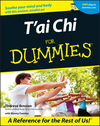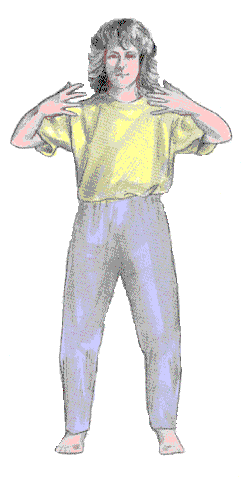Qigong or Chi Gung
The practice called qigong is a close cousin to Tai Chi. It's pronounced "CHI GUNG" and can be spelled that way. It's discussed at some length in the book pictured at right, T'ai Chi for Dummies .
.The qi or Chi spoken of in the name of this meditation method refers to the energy which flows in your body. It needs to flow freely along certain pathways or meridians, but when the body grows tense, the muscles and joints clench up, or the posture is wrong, the meridians become kinked, like hoses. Energy doesn't flow right, with all kinds of negative results.
Qigong fixes that. Through it, you learn to right your posture, relax your muscles, and "root" your body firmly to the earth, such that the earth's energy can flow into you and add to your Chi.
Qigong is done with only very gentle movements, or none at all. The exercises are meant to (among other things) get your "microcosmic orbit" going properly. That's a loop of energy flow that runs up the front of your body from the dan tien point ("DON TYEN," "elixir field") between your belly button and pubic bone. It ascends all the way to the bai hui ("BY HWAY," "hundred meetings") point atop your head. Then it heads down the back side of you, passing through the ming men ("MING MUN," "gate of life") point between your kidneys. From there, it curves down through your pubic area and up again to rejoin the dan tien.
One of the perhaps surprising things about all this is that the dan tien is thought of as a storehouse of sexual energy. This sexual energy needs to flow all around the "microcosmic orbit."
One of the basic qigong exercises is "Standing Like a Tree."
 The Chinese for it is zhang zhuang, "JAN JWANG." It involves no movement at all. Although Therese Iknoian, author of T'ai Chi for Dummies, describes five different variations of Standing Like a Tree, different in terms of how you hold your hands and arms, the posture shown at left is typical. It is the posture known as Embracing the Tree or Embracing the Heavens. The illustration comes from this web page, a part of CHI Online, the website of the Center for Holistic Instruction. Check out their page devoted to Tai Chi itself here.
The Chinese for it is zhang zhuang, "JAN JWANG." It involves no movement at all. Although Therese Iknoian, author of T'ai Chi for Dummies, describes five different variations of Standing Like a Tree, different in terms of how you hold your hands and arms, the posture shown at left is typical. It is the posture known as Embracing the Tree or Embracing the Heavens. The illustration comes from this web page, a part of CHI Online, the website of the Center for Holistic Instruction. Check out their page devoted to Tai Chi itself here.Another variation of Standing Like a Tree has you simply hang your hands at your side, keeping everything else the same as in Embracing the Tree ... in which case you are basically in the Wu Chi or "Infinite Ultimate" position I talked about here and here.
You simply stand in one of these positions for anywhere from 2-3 minutes, early on, to 20-30 minutes as you gain proficiency. You take care to get your posture just right, according to instructions Ms. Iknoian gives (pp. 76-78), because any defects of posture will kink up your Chi hose. As you stand there, the idea is that you can't help but enter a meditative state ... as, also, your Chi commences to flow optimally. (Of course, it may take days, weeks, or months of practicing before you achieve this result.)
In my earlier posts, I suggested that entering the Wu Chi posture seemed to do me good almost instantly. It really woke me up, making me come noticeably alive, while at the same time making me feel relaxed and mindful.
It even relieved me of the pressing urge to use the toilet, a relief which lasted several hours.
I personally can really relate to a meditation method which does not require doing anything mentally arcane, but just cultivates the body's own natural ability to bring the mind along with it! I'll be trying some of the qigong exercises and reporting back.











0 Comments:
Post a Comment
<< Home